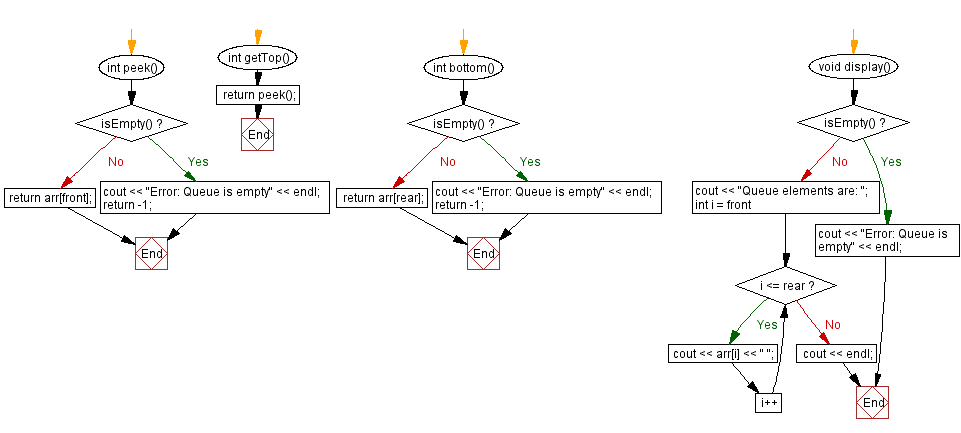C++ Queue Exercises: Find the top and bottom elements of a queue
21. Find Top and Bottom Elements of a Queue
Write a C++ program to find the top and bottom elements of a queue.
Sample Solution:
C Code:
#include <iostream> // Including necessary library for input and output operations
using namespace std;
const int MAX_SIZE = 100; // Maximum size for the queue
class Queue {
private:
int front; // Front of the queue
int rear; // Rear of the queue
int arr[MAX_SIZE]; // Array to store queue elements
public:
Queue() {
front = -1; // Initializing front index to -1
rear = -1; // Initializing rear index to -1
}
bool isFull() {
return (rear == MAX_SIZE - 1); // Check if the queue is full
}
bool isEmpty() {
return (front == -1 && rear == -1); // Check if the queue is empty
}
void enqueue(int x) {
if (isFull()) {
cout << "Error: Queue is full" << endl; // Display error if the queue is full
return;
}
if (isEmpty()) {
front = 0;
rear = 0;
}
else {
rear++;
}
arr[rear] = x; // Add an element to the rear of the queue
}
void dequeue() {
if (isEmpty()) {
cout << "Error: Queue is empty" << endl; // Display error if the queue is empty
return;
}
if (front == rear) {
front = -1;
rear = -1;
}
else {
front++;
}
}
int peek() {
if (isEmpty()) {
cout << "Error: Queue is empty" << endl; // Display error if the queue is empty
return -1;
}
return arr[front]; // Return the element at the front of the queue
}
// Function to get the top element of the queue
int getTop() {
return peek();
}
// Function to get the bottom element of the queue
int bottom() {
if (isEmpty()) {
cout << "Error: Queue is empty" << endl; // Display error if the queue is empty
return -1;
}
return arr[rear]; // Return the element at the rear of the queue
}
void display() {
if (isEmpty()) {
cout << "Error: Queue is empty" << endl; // Display error if the queue is empty
return;
}
cout << "Queue elements are: ";
for (int i = front; i <= rear; i++) {
cout << arr[i] << " "; // Display all elements in the queue
}
cout << endl;
}
}; // End of Queue class
int main() {
cout << "Initialize a Queue." << endl;
Queue q1; // Creating an instance of Queue
cout << "\nInsert some elements into the queue:" << endl;
q1.enqueue(1);
q1.enqueue(2);
q1.enqueue(3);
q1.enqueue(4);
q1.enqueue(5);
q1.enqueue(6);
q1.display(); // Display elements of the queue
cout << "\nTop element of the Queue is: " << q1.getTop() << endl; // Get the top element of the queue
cout << "Bottom element of the Queue is: " << q1.bottom() << endl; // Get the bottom element of the queue
cout << "\nRemove two elements from the above Queue:" << endl;
q1.dequeue();
q1.dequeue();
q1.display(); // Display elements of the queue after dequeuing
cout << "\nTop element of the Queue is: " << q1.getTop() << endl; // Get the top element of the updated queue
cout << "Bottom element of the Queue is: " << q1.bottom() << endl; // Get the bottom element of the updated queue
return 0;
}
Sample Output:
Initialize a Queue. Insert some elements into the queue: Queue elements are: 1 2 3 4 5 6 Top element of the Queue is: 1 Botttom element of the Queue is: 6 Remove two elements from the above Queue: Queue elements are: 3 4 5 6 Top element of the Queue is: 3 Botttom element of the Queue is: 6
Flowchart:



For more Practice: Solve these Related Problems:
- Write a C++ program to identify and display both the front and rear elements of a queue.
- Write a C++ program to print the first and last elements of a queue without altering the queue.
- Write a C++ program that retrieves the top and bottom elements of a queue and highlights them during output.
- Write a C++ program to implement a routine that reports the first and last values stored in a queue with error checks.
Go to:
PREV : Copy One Queue to Another.
NEXT : Get the Nth Element from the Bottom of a Queue.
CPP Code Editor:
Contribute your code and comments through Disqus.
What is the difficulty level of this exercise?
